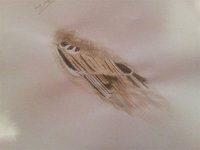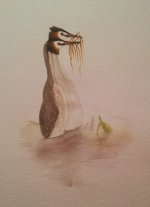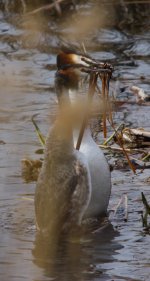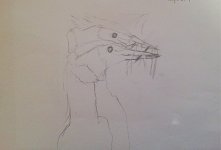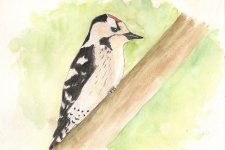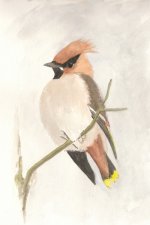Hi, I have recently started to paint again, it's something I have always wanted to do but never found a subject passionate enough to pursue, thanks to Alan Dalton and some of his contacts I have realized that my birdwatching/photography is the way to go.
I'm not really here as much to show my work but to get constructive feedback/criticism, possible new methods/techniques/ways of approaching a piece.
I don't really get out much due to 3 kids and running a full time business, I would love to get more time to field sketch birds and other things around the birds environment but at the same time I usually focus what time I have on seeing, learning and photographing as many species as I can (cramming in as much as physically possible). I know I would benefit from field sketching and probably will end up trying it when the weather is more friendly anyway.
Right now it's just a big learning curve, I think I want to paint something between realism and field sketches with watercolor washes like Irish Bird Art on facebook, almost take that style somewhat more towards realism. Again I'm just learning now so I don't really know what my style is going to be or what I need to focus on more. So tips/thoughts on that as well would be great.
I'm sure I can take this discussion further when/if anyone replies - sorry if what I have written is a bit "loose".
for example I done this from one of my photos: http://birdpaintings.files.wordpress.com/2012/01/northern-wheatear.jpg
as I test for myself I superimposed my painting and the photo to see if I had painted what I could see and what was on the bird - the colors are a bit off but again I'm more getting used to watercolor paint and what I can achieve with it. I'm amazed every time I mix colors with the results it gives and how little of one color you need to make a completely different color (I must do a color mixing chart just for learning about the colors more).
I also took that little feather section and added some pencil (2b or 3b) just to darken the really dark feather and hopefully to lift and define little bits. That came out like the attached. I wonder what can be done to get more out of that? ink would give too dark lines I think (not really what I am after either). Can anything be done/added to make the feathers look "wow"?
Loads of writing, loose questions, hope someone has the time to write back, Thanks all
I'm not really here as much to show my work but to get constructive feedback/criticism, possible new methods/techniques/ways of approaching a piece.
I don't really get out much due to 3 kids and running a full time business, I would love to get more time to field sketch birds and other things around the birds environment but at the same time I usually focus what time I have on seeing, learning and photographing as many species as I can (cramming in as much as physically possible). I know I would benefit from field sketching and probably will end up trying it when the weather is more friendly anyway.
Right now it's just a big learning curve, I think I want to paint something between realism and field sketches with watercolor washes like Irish Bird Art on facebook, almost take that style somewhat more towards realism. Again I'm just learning now so I don't really know what my style is going to be or what I need to focus on more. So tips/thoughts on that as well would be great.
I'm sure I can take this discussion further when/if anyone replies - sorry if what I have written is a bit "loose".
for example I done this from one of my photos: http://birdpaintings.files.wordpress.com/2012/01/northern-wheatear.jpg
as I test for myself I superimposed my painting and the photo to see if I had painted what I could see and what was on the bird - the colors are a bit off but again I'm more getting used to watercolor paint and what I can achieve with it. I'm amazed every time I mix colors with the results it gives and how little of one color you need to make a completely different color (I must do a color mixing chart just for learning about the colors more).
I also took that little feather section and added some pencil (2b or 3b) just to darken the really dark feather and hopefully to lift and define little bits. That came out like the attached. I wonder what can be done to get more out of that? ink would give too dark lines I think (not really what I am after either). Can anything be done/added to make the feathers look "wow"?
Loads of writing, loose questions, hope someone has the time to write back, Thanks all




